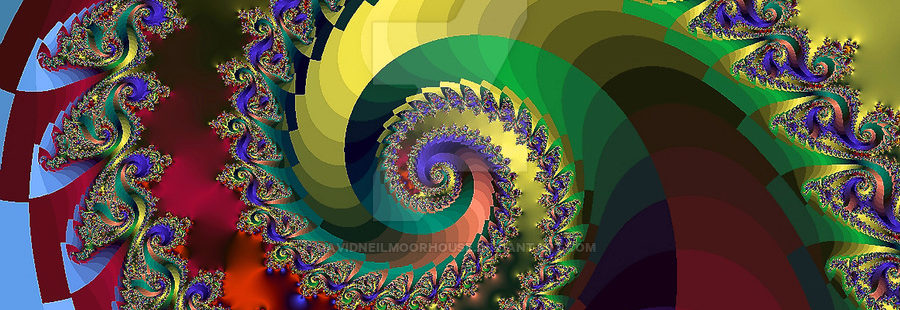In many ways, the beauty of mathematics is overlooked by many high school students who just see it as an unnecessary nuisance in their lives. However, math is full of many amazing and enlightening ideas that many people overlook. One of the most amazing and accessible of these is the idea of fractals like the one to the left. In this article, you do not need to have that much mathematical knowledge but your experience will be greatly enhanced if you know about logarithms. While reading this article, do not be afraid to get out a piece of paper and a pencil to convince yourself of some of the assertions in this paper, in fact, it is encouraged that you do read this with a pen and paper in hand. To start we

will first define a fractal. A fractal has two main properties, the first is that is self-similar and the second is that it has a non-integer dimension. Self-similar means that fractals are formed by a certain algorithm like the famous Koch snowflake (left) which is formed by a series of triangles. You can also see on the Koch snowflake that when you zoom in on it the general pattern stays the same. This is the property of self-similarity that all fractals have. Fractal dimension is a bit harder to explain and will require the use of logarithms which are just the inverse of exponential functions. If you do not know anything about logarithms there will be a brief explanation below. To calculate the fractal dimension the Hausdorff-Besicovitch method is used in this article. To start, first, analyze what we mean by dimension. First, we look at a line. When you scale a line down by a factor of ½, the length of the resulting image is a line with half the length. However, when you scale down a square by a factor of ½, the area of this square is now ¼ that of the original square (when scaling down each dimension of the square by ½). When you scale down any 2-dimensional shape by a factor of ½ the resulting area will be ¼ of the original. Likewise, when you scale down any 3-dimensional shape by ½ the resulting volume will be ⅛ of the original. You should have noticed that if you scale down an n-dimensional object by a factor of ½ the resulting measure of its respective n-dimensional quantity (e.g. length is 1-dimensional, the area is 2-dimensional etc.) is multiplied by1/2n. It should be noted that this applies to any scaling factor where the scaling factor could be anything from ⅓ to 2000. To show you how to find fractal dimension the fractal called Sierpinski’s triangle which is constructed from an infinite series of triangles will be used. As
you can see from the image to the left if we were to scale down a Sierpinski triangle by a factor of ½ the result would be one of the 3 smaller Sierpinski triangles that compose the larger one. If this Sierpinski triangle were made out of some tangible material like a wire mesh, we would say that scaling it down by a factor of 2 would result in something with ⅓ as much mass. So to find the dimension of this we have to find what power of ½ is equal to ⅓ or in equation form:

To solve this we use logarithms which are defined as the opposite of exponential functions. So log(ba)=a. Using this we can find that:
![]()
This shows us that the fractal dimension of the Sierpinski triangle is around 1.58. This number is approximate where the actual value can be calculated by taking the limit of the scaling factor to 0. So now that we have defined fractal dimension we can now calculate it for numerous famous fractals like Barnsley’s Fern which is used in video game graphics. With this tool we can describe the sort of roughness of objects in which objects of a lower fractal dimension are not as rough as those of larger fractal dimension. The idea of roughness is brought up because the idea of fractals was first used by cartographers to help calculate the length of coastlines. Using scaled down models they needed to know by
what factor to multiply the lengths they found to get the length of coastlines of the actual countries. For example, the fractal dimension of Great Britain is around 1.21. This connection between the seemingly abstract realm of fractal dimensions and the genuine problem of finding the length of coastlines just goes to show you how incredible mathematics is and how the craziest and seemingly uselessly novel ideas can have real-world impacts. If you enjoyed this article I hope that you consider reading the next one in which readers will explore deeper into this world of fractals focusing more specifically into Julia sets and the related Mandelbrot set. It would probably be a good idea for you to brush up on your complex numbers and the idea of the complex plane before reading this next entry although a brief review will be included. Below are some interesting related problems to ponder at your leisure which I hope you will enjoy.
- Can you create your own fractal? What is the process you used to create this fractal? Can you calculate its fractal dimension?
- What is the area of the Koch snowflake in which you start with an equilateral triangle with side length 1?
- Can you create a 3-dimensional fractal?
- The fractal dimensions of the above fractals are all irrational numbers. Do the fractal dimensions of fractals always have to be irrational? If not, see if you can construct a fractal with non-integral and rational dimension.






